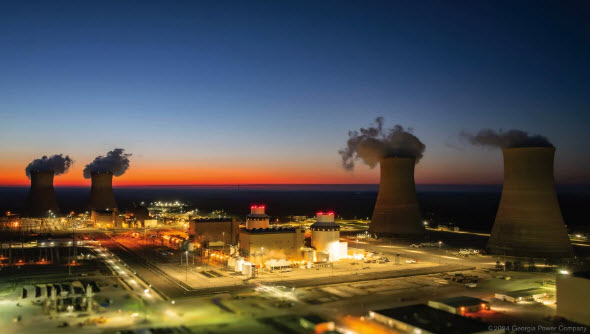The Energy Information Administration (EIA) projects significant growth in U.S. utility-scale generation in 2025, with 63 GW of new capacity expected—an almost 30% increase over 2024. Solar and battery storage will dominate, accounting for 81% of the additions, with Texas and California leading in solar expansion. Battery storage capacity is also set to nearly double, while wind additions will increase modestly, and natural gas will contribute a smaller share.
ESG & Industry Updates
Massachusetts passed a long awaited and much debated climate change bill this week and sent it to Governor Healey’s desk Thursday afternoon.
Topics: Massachusetts, Climate Change, renewable energy, environmental justice
In early May of 2024, the New Jersey Township of North Brunswick conducted an initial trial of renewable diesel y fueling the township's DPW trucks with Neste MyRenewable Diesel. Now, all of North Brunswick's public fleet, including school busses, fire trucks, and backup generators are powered by renewable diesel. This move is projected use around 50,000 gallons a year and result in a reduction of GHG emissions by 470 tons annually.
Topics: Carbon Emissions, renewable energy, renewable diesel
The Clean Fuel Production Credit is part of the Inflation Reduction Act passed in 2022. The Act includes substantial provisions for climate initiatives including the aforementioned credit, and multiple provisions regarding EV incentivization.
Topics: Biodiesel Tax Credit, Biodiesel, Climate Change, Carbon Emissions, renewable energy, Inflation Reduction Act, Clean Fuel Production Credit
The Biodiesel Blender Tax Credit is set to expire at the end of 2024, at which point it will be replaced by the Clean Fuel Production Credit. The Clean Fuel Production credit (somewhat obviously) accrues credit to producers of clean transportation fuels produced at approved facilities for approved uses and does NOT carry through to blenders of clean transportation fuels like biodiesel and renewable diesel.
Topics: Biodiesel Tax Credit, Biodiesel, Carbon Emissions, renewable energy, Clean Fuel Production Credit
Two new nuclear reactors in Georgia at Plant Vogtle are the first new reactors built in the United States in 30 years. Each of them will power 500,000 homes and businesses with clean nuclear energy.
Topics: Oil & Energy Magazine, Carbon Emissions, renewable energy, net-zero, power plants, nuclear
January 2024 saw the first operational turbine on the Vineyard Wind project deliver 5 megawatts of power to the New England electrical grid. The project began in 2022 and upon completion is projected to generate 800 megawatts of electricity, reducing carbon emissions by 1.6 million tons per year.
Topics: renewable energy, offshore wind, vineyard wind
The UN’s Climate Change Conference, or “COP28” Summit was held from November 30 through December 13th in Dubai, UAE. The Conference consisted of 150 heads of State and Government and 85,000 participants representing countries, organizations, etc. This year’s summit focused on where the world is in relation to the goals initially outlined in the Paris Agreement (forget what that is? Refresher here: LINK). Spoiler alert – the world is nowhere near achieving the goals outlined, and the focus became how the countries involved can speed up their action on climate change mitigation through multiple avenues.
Topics: methane, Climate Change, Carbon Emissions, renewable energy, paris accord
Independent research organization Climate Central published a report recently that showed how the national capacity for solar and wind generated power shot up in 2022. The report comes just as the Biden Administration begins rolling out billions of dollars to renewable energy projects as part of its commitment to decarbonizing the grid completely by 2030 and getting the US to net zero emission by 2050.
Topics: Solar, Carbon Emissions, renewable energy, Biden Administration, offshore wind, decarbonization
Topics: EPA, Carbon Emissions, railcar regulations, renewable energy, Biden Administration, decarbonization
Subscribe to Email Updates
Recent Posts
Posts by Topic
- Carbon Emissions (42)
- Climate Change (32)
- renewable energy (31)
- Oil & Energy Magazine (27)
- EPA (24)
- Massachusetts (21)
- Biden Administration (18)
- decarbonization (15)
- Biodiesel (12)
- natural gas (12)
- EPA Mandate (11)
- RFS (11)
- Solar (11)
- Biofuels (10)
- Keystone XL (10)
- methane (10)
- Clean Energy (9)
- offshore wind (9)
- Energy Independence (8)
- Energy Infrastructure (8)
- Safety (8)
- Biodiesel Tax Credit (7)
- Emissions (7)
- Ethanol (7)
- ev (7)
- Cellulosic Ethanol (6)
- EV Charger (6)
- RINs (6)
- Trump Administration (6)
- environmental justice (6)
- Fracking (5)
- Inflation Reduction Act (5)
- Technology (5)
- US Crude Exports (5)
- Utility Rates (5)
- electric vehicles (5)
- maine (5)
- tesla (5)
- ACT (4)
- Mass DOER (4)
- TransCanada (4)
- battery (4)
- fuel management (4)
- massachusetts biodiesel mandate (4)
- obama (4)
- paris accord (4)
- remote tank monitoring (4)
- CARB (3)
- CRUDE (3)
- Carbon Capture (3)
- Clean Fuel Production Credit (3)
- E85 (3)
- Emergency Fuel (3)
- Massachusetts Clean Cities (3)
- Waste Feedstock Biodiesel (3)
- china (3)
- clean power plan (3)
- electricity rates (3)
- net-zero (3)
- renewable diesel (3)
- solid state battery (3)
- AI (2)
- AVs (2)
- Bioheat (2)
- Commodities (2)
- Congress (2)
- Customer Service (2)
- DOT (2)
- EIA (2)
- Emergency Generator Program (2)
- HFCs (2)
- Hurricane Sandy (2)
- IMO 2020 (2)
- MIT (2)
- Marinas (2)
- New York (2)
- Refinery Closures (2)
- Safe Driving Policy (2)
- TCI (2)
- US Energy Boom (2)
- ZEV (2)
- autonomous vehicles (2)
- clean air act (2)
- coal (2)
- driver shortage (2)
- emergency response (2)
- environment (2)
- ferc (2)
- geothermal (2)
- hydro-electric (2)
- hydrogen (2)
- national grid (2)
- net metering (2)
- power plant emissions (2)
- power plants (2)
- railcar regulations (2)
- tariff (2)
- vineyard wind (2)
- API (1)
- Air conditioning (1)
- Baiji Refinery (1)
- Blend Wall (1)
- Brent Crude (1)
- Brent vs WTI (1)
- CFCs (1)
- Cell Phone Policy (1)
- Clean Water Act (1)
- DEF (1)
- Election Results (1)
- Electrical Grid (1)
- Energy Efficiency (1)
- Environmental Impact Study (1)
- Environmentally Friendly Products (1)
- Ethanol Tax Credit (1)
- FEMA (1)
- Fiscal Cliff (1)
- Gas Tax (1)
- Gasoline Supply Crunch (1)
- HDVC (1)
- Hazmat (1)
- Heat Tax (1)
- Highway Trust Fund (1)
- Holyoke (1)
- Hybrid (1)
- ISIS (1)
- Iraq (1)
- Kigali Amendment (1)
- MOC (1)
- Market analysis (1)
- Mayflower (1)
- Montreal Protocol (1)
- NORA (1)
- Natural Gas Pipeline Explosion (1)
- New Jersey (1)
- Oil Barrel Tax (1)
- PFC (1)
- Pegasus Pipeline (1)
- Propane Autogas (1)
- Stimulus (1)
- Syria (1)
- Tank Truck Safety Training (1)
- Tax Increases (1)
- Tier 3 Gasoline Standard (1)
- Times Square (1)
- VEEP (1)
- Workplace Risk (1)
- agriculture (1)
- algonquin pipeline (1)
- alternative energy (1)
- altwheels (1)
- astm (1)
- bionic leaf (1)
- bitcoin (1)
- boston (1)
- clean heat standard (1)
- covid-19 (1)
- energy storage (1)
- eversource (1)
- export ban (1)
- fixed pricing (1)
- fuel (1)
- fuel efficiency (1)
- fuel marketers news (1)
- gas leaks (1)
- heating oil (1)
- hurricane harvey (1)
- inflation (1)
- irving oil (1)
- marketing (1)
- nuclear (1)
- online fuel buying (1)
- ozone (1)
- photovoltaic (1)
- pilot program (1)
- pipeline (1)
- propane (1)
- renewable natural gas (1)
- rggi (1)
- russia (1)
- sanctions (1)
- senate (1)
- shale (1)
- social media (1)
- social media for business (1)
- space (1)
- tablets (1)
- tennessee pipeline (1)
- ukraine, (1)
- value added services (1)






.jpg)

